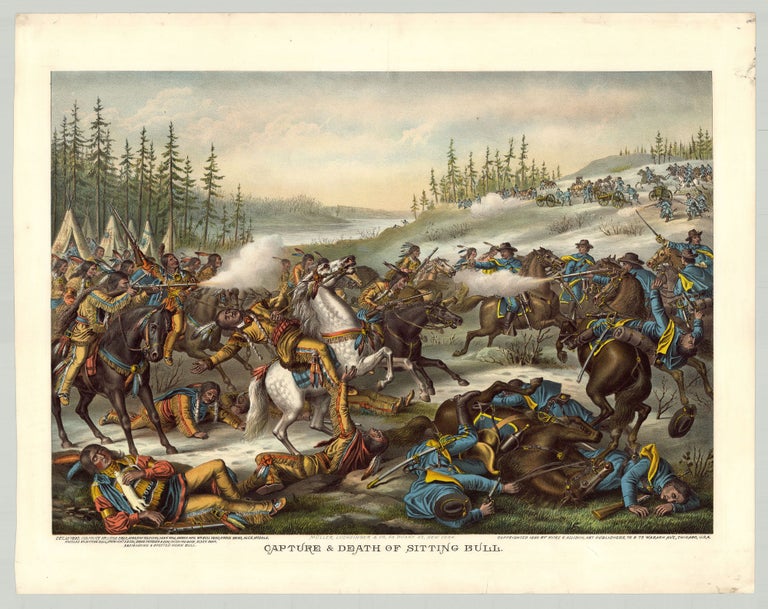Capture & Death of Sitting Bull.
New York: Müller, Luchsinger & Co., 1890. Kurz & Allison, Art Publishers [lithographers], Chicago. Chromolithograph, 17.5” x 25” plus margins. A scarce chromolithograph depicting the death of Sitting Bull at Standing Rock Reservation on December 15th, 1890, published shortly after the event. This lithograph dramatizes the capture and death of Sitting Bull (1831–1890) as a full-scale battle between the Lakota followers of the Chief, on the one hand, and Indian police and white soldiers on the other. Sitting Bull is shown in the middle of the print, falling backwards off his rearing white horse after being shot. Teepees appear in the background along with U.S. Army artillery firing from a hillside and the Grand River winding away toward the horizon. Text in the lower margin makes note of the deaths of Indian policemen and “hostiles”: “Dec. 15’ 1890. Ind. Police Kd. Little Eagle, Afraid of Soldiers, Hawk Man, Broken Arm, Wo. Bull Head, Shave Head, Alex. Middle. Hostiles Kd. Sitting Bull, Crow-Foot S.B. Son, Brave Thunder & Son, Catch-the-Bear, Black Bear, Assinaboine & Spotted Horn Bull.” When the Ghost Dance movement arose among the Lakota in the late 1880s, Indian agents feared—without evidence—that it would lead to an uprising led by Sitting Bull. On December 14th, 1890, agent James McLaughlin ordered Indian police to arrest the chief at his cabin on the Grand River, an order they carried out the next morning, hoping to quietly take Siting Bull into custody before his followers were stirring. When Sitting Bull first stalled, then put up resistance, gun fire erupted from a crowd that had gathered, and all hell broke loose. In the end, Sitting Bull—shot in the chest and head—seven of his Lakota followers, and six policemen lay dead. Only a few weeks later the U.S. army would mercilessly suppress the Ghost Dance movement by massacring a group of Lakota at Wounded Knee, constituting the final tragic event in America’s long war against the Plains people. Deeply skeptical from his youth of any contact with whites, Sitting Bull (Tatanka Iyotake) vigorously sought to preserve Lakota independence and their traditional way of life. However, his stance of noncompliance became increasingly untenable in the face of both westward expansion and the federal government’s confinement of Native Americans to reservations. Declining to follow an 1875 order to move his people to a reservation resulted in the Battle of the Little Bighorn, in which the Lakota, Cheyenne, and Arapaho decimated five troops of Custer’s 7th Cavalry. Following the battle, Sitting Bull and his people took refuge in Canada for four years—only to return and capitulate in 1883 when they faced mass starvation there, whereupon he and his people were relocated to the Standing Rock reservation. Kurz & Allison Co. was established by Austrian-born Louis Kurz (1835–1921) who, upon emigrating to the U.S., fought in the Union Army and in 1880 established a lithographic firm with William Allison in Chicago. Known for their lithography which often depicted sensational subjects such as war, fires, natural disasters and even scenes of nude female bathers, the company lasted until Kurz’s death in 1921. REFERENCES: Sitting Bull killed by Indian police at history.com CONDITION: Very good, minor soiling in the margins.
Item #5204
Sold


